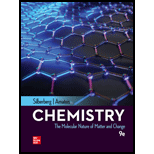
Concept explainers
Interpretation:
The key difference between an element and a compound is to be determined.
Concept introduction:
An element can be defined as the simplest type of matter which is composed of only one kind of atom and cannot be broken down further. The properties of all the atoms of an element are identical.
A compound is defined as a substance formed by the combination of two or more different elements in a fixed proportion via
Answer to Problem 2.1P
The key difference between an element and a compound are as follows:
1. An element is made up of only one kind of atoms whereas compounds are made up of more than one kind of elements.
2. Elements cannot be broken down further whereas compounds can be broken down into two or more simpler substance.
Explanation of Solution
Elements are the simplest form of matter composed of only one type of atom. Hence elements can be represented by symbols. Elements cannot be broken down into simpler substances by any chemical or physical means. Examples are – carbon, hydrogen, oxygen, sulfur, chlorine.
Compounds are formed by the combination of two or more different elements in a fixed ratio. Compounds are represented by using chemical formulas which contain the alphabetical
The key difference between an element and a compound is that while a compound can be broken down into simpler forms, an element is the simplest form of matter and thus cannot be broken down any further.
The key difference between an element and a compound is that a compound can be broken down into simpler forms, while an element is the simplest form of matter and thus cannot be broken down any further. Examples of elements are sulfur
Want to see more full solutions like this?
Chapter 2 Solutions
CHEMISTRY:MOLECULAR...(LL)-W/CONNECT
- If the current voltage is n = 0.14 V. Indicate which of the 2 formulas must be applied a) = a T = i exp[(1 - p) F Fn Fn b) i==exp B RTarrow_forwardTopic: Photochemistry and Photophysics of Supramoleculesarrow_forwardTwo cations that exchange an electron in an interface, the exchange density is worth 1.39 mA/cm2 and the current density is worth 15 mA/cm2 at 25°C. If the overvoltage is 0.14 V, calculate the reaction rate and symmetry factor. Data: R = 8,314 J mol-1 k-1: F = 96500 Carrow_forward
- With the help of the Tafel line, it is estimated that the interchange density of the VO2+/VO2+ system on the carbon paper has a value of 3 mA cm-2. Calculate a) the current density if the voltage has a value of 1.6 mV and the temperature is 25°C. b) the beta value of the anódico process if the Tafel pendulum is 0.6 V at 25°C. Data: R = 8.314 JK-1mol-1, y F = 96485 C mol-1.arrow_forwardApply the NANSTE law to the MnO4- + 8H+ + 5e- ⇄ Mn2+ + 4H2Oarrow_forwardIn the Nernst Law, how much is RT / F?arrow_forward
 ChemistryChemistryISBN:9781305957404Author:Steven S. Zumdahl, Susan A. Zumdahl, Donald J. DeCostePublisher:Cengage Learning
ChemistryChemistryISBN:9781305957404Author:Steven S. Zumdahl, Susan A. Zumdahl, Donald J. DeCostePublisher:Cengage Learning ChemistryChemistryISBN:9781259911156Author:Raymond Chang Dr., Jason Overby ProfessorPublisher:McGraw-Hill Education
ChemistryChemistryISBN:9781259911156Author:Raymond Chang Dr., Jason Overby ProfessorPublisher:McGraw-Hill Education Principles of Instrumental AnalysisChemistryISBN:9781305577213Author:Douglas A. Skoog, F. James Holler, Stanley R. CrouchPublisher:Cengage Learning
Principles of Instrumental AnalysisChemistryISBN:9781305577213Author:Douglas A. Skoog, F. James Holler, Stanley R. CrouchPublisher:Cengage Learning Organic ChemistryChemistryISBN:9780078021558Author:Janice Gorzynski Smith Dr.Publisher:McGraw-Hill Education
Organic ChemistryChemistryISBN:9780078021558Author:Janice Gorzynski Smith Dr.Publisher:McGraw-Hill Education Chemistry: Principles and ReactionsChemistryISBN:9781305079373Author:William L. Masterton, Cecile N. HurleyPublisher:Cengage Learning
Chemistry: Principles and ReactionsChemistryISBN:9781305079373Author:William L. Masterton, Cecile N. HurleyPublisher:Cengage Learning Elementary Principles of Chemical Processes, Bind...ChemistryISBN:9781118431221Author:Richard M. Felder, Ronald W. Rousseau, Lisa G. BullardPublisher:WILEY
Elementary Principles of Chemical Processes, Bind...ChemistryISBN:9781118431221Author:Richard M. Felder, Ronald W. Rousseau, Lisa G. BullardPublisher:WILEY





